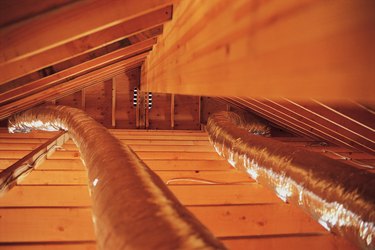 Attics tend to run the entire length of a house. Image Credit: Comstock/Comstock/Getty Images
Attics tend to run the entire length of a house. Image Credit: Comstock/Comstock/Getty Images
For the most part, the terms attic and loft are interchangeable when referring to certain type of space in a building, particularly in a home. However, there are technical and contextual differences between the terms and actual spaces, including their size and purpose. There are also different types of loft spaces, which further separates the two.
Video of the Day
Size
Size is perhaps one of the biggest differences between an attic and loft space. Typically, an attic runs the entire length of a home or building, while a loft is only part of it, sitting above and often overlooking a larger area. However, in barns, the loft area may be larger than the ground floor because it's used for storing hay. Since attics are traditionally used for storage, they are much larger, though modern variations break these conventions.
Purpose
In residential homes, attics' intended purpose is most often for storage. However, in areas where residential space is limited, they're also commonly turned into living areas, as they are in the United Kingdom. A loft may also be used for storage, but if it has an open design and is located in a home, it's usually used for living or as a bedroom. Its design typically matches the rest of the home, where an attic may be unfinished and even lack the heating, cooling, and ventilation the other rooms receive.
Other Types of Lofts
Lofts typically have a particular purpose, especially when they're not located in a home. A church loft, for instance, is usually expressly for a choir or organ. A rigging loft is located in shipyards and is used for fitting purposes, while a parachute loft provides riggers a place to repack parachute containers. Storage lofts may also be used in stores or warehouses.
Loft Apartments
Contemporary use of the word loft also refers to a type of living and work space. Originally, these spaces were used by artists who converted industrial factories, warehouses and spaces into apartments and studios. The term later applied to new apartments with these types of designs. A loft is usually a large, open area and traditionally has plenty of windows, and perhaps even a raised loft area within the apartment itself. Converted attics may have a similar feel, depending on their location, but lofts are associated with an especially industrial and artistic context.







































